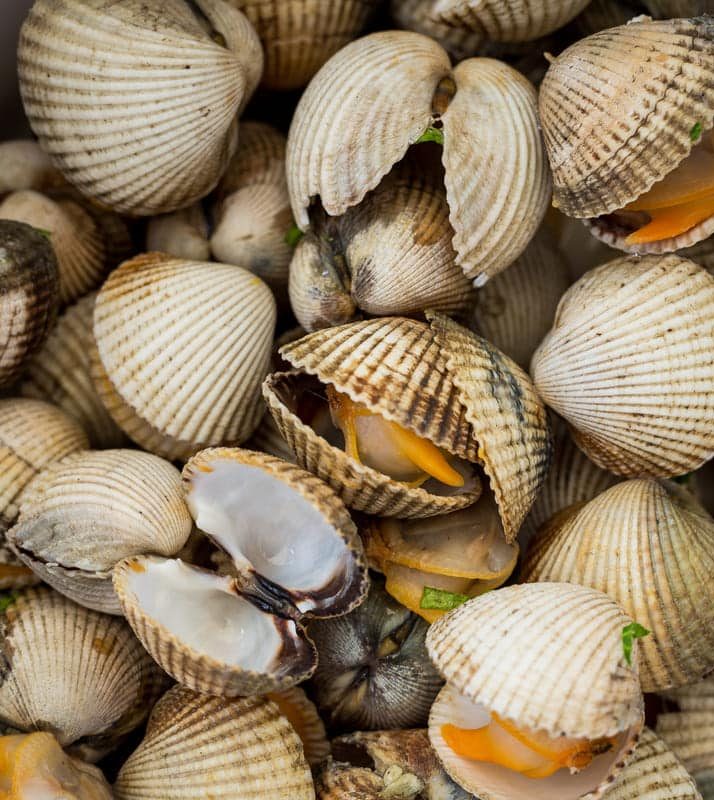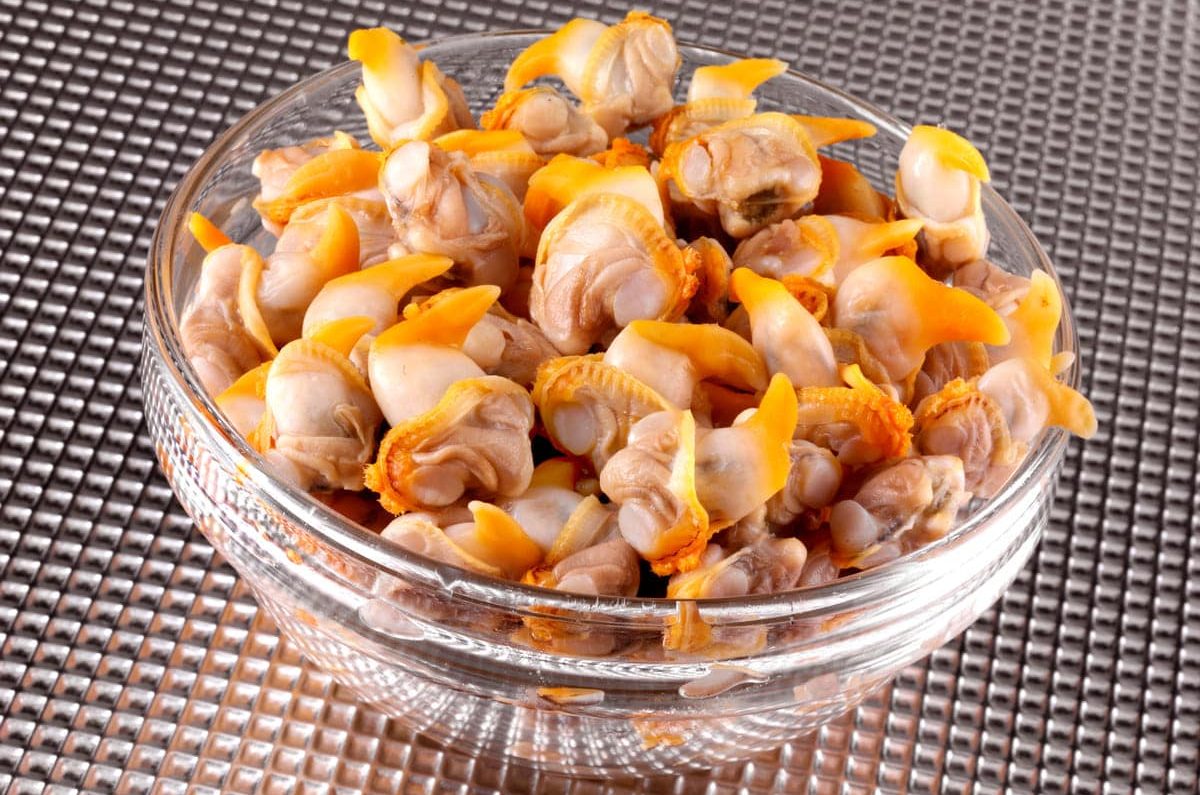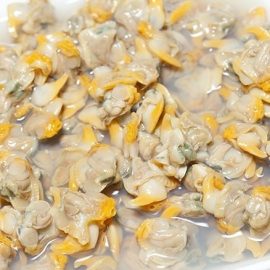
Introduction
Cockles, a type of small, edible, burrowing mollusc, are found in tidal and subtidal areas of the world’s oceans, estuaries, bays, creeks, and rivers.
Since prehistoric times, they are now a popular delicacy consumed worldwide, either cooked or raw. They are widely known for their delicate and flavorful meat and for providing an essential nutrition source to humans and marine life.
Their presence in the environment helps to balance the ecosystem, and they can be sustainably harvested and managed to benefit fisheries and aquaculture.
Description
Cockles are an incredibly diverse group of marine bivalves and play an important role in global coastal ecosystems. As filter water feeders, they are essential for maintaining water quality, while they have also been harvested and consumed by humans for thousands of years.
It is estimated that there are more than 180 species of cockles, classified among twelve families, distributed across Europe, Asia, South Africa, and Australia.
The Cerastoderma edule (common cockle) is the most common species. The Cerastoderma edule has a smooth, rounded and circular shell, a yellowish-brown to purplish-brown colour and usually reaches up to 4 cm in size.
Physical Characteristics
Cockles (family Cardiidae) are small, edible bivalve molluscs in various marine habitats worldwide. They are characterised by their convex, asymmetrical shells measuring 1-2 inches in diameter, with a beige to dark grey exterior and a reddish-brown interior containing concentric ridges. Cockles possess two pairs of antennae and two eyes, one on either side of the mantle, and move using a fan-shaped foot.
Additionally, fresh cockles possess a dark strip or line along the length of the shell and a hinged door to close the two cockle shells together, making them appear rectangular or heart-shaped when viewed from the outside.
Habitat
The habitat and distribution of the best cockles are primarily determined by their tolerance to water temperature, salinity, oxygen and pH levels, as well as the availability of food. During low tide, they burrow into the sand or mud and emerge when the tide rises to seek food in intertidal areas, such as coasts, estuaries, rivers, and seashores.
Cockles typically prefer weak tidal currents, where the sand is mixed with mud and sparse vegetation like seagrass beds. In deeper and colder water (below 25m), they can be found inhabiting the Mediterranean and Black Sea mud floor.

Distribution of Stocks
Cockles (Cardiidae) are a cosmopolitan family of edible bivalve molluscs in temperate and tropical coastal regions worldwide. Primarily found in intertidal habitats in the northeastern Atlantic Ocean and parts of the Mediterranean Sea, cockles are also dispersed throughout European countries such as the UK, France, Ireland and Scandinavia, as well as North Africa, North America and the Indo-Pacific.
Cockle Fisheries
Cockles are essential in many coastal economies, providing commercial, recreational, and subsistence fisheries. Through their collection, local communities have benefited from this valuable resource, with generations of knowledge being passed down to ensure sustainable harvesting from their natural environment.
Fishing Trawls
Fishing trawls are the most common harvesting technique utilised for cockles and involve towing a net behind a boat. Different designs have been implemented, such as otter and beam trawls, to collect this small bivalve mollusc effectively.
Dredging and Raking
In addition to trawling, cockles near the sea bed can be collected through dredging. This technique involves the use of a mechanical arm, which is employed to sweep the sea floor for any cockles present. Additionally, raking is a technique which is commonly used by “cockling boats”. This method requires the use of a rake, which is used to collect cockles from the sand.
Hand-Gathering
Hand-gathering is the traditional method of cockle harvesting, adopted from ancient practices. This low-impact collection method only requires the use of the hands and is commonly used for small-scale, recreational fishing.
Other Collection Methods
Other collection methods which may be employed when harvesting cockles include traps, beach seines, and scoop nets. Long-lined fisheries also utilise fleets of small boats to deploy the attaching lines to catch cockles, while artificial cockle beds may feature gathering hooks and mesh fishing pots. In addition, scuba diving and hookah diving can be used to catch cockles from recreational fisheries, while the steam net is utilised in commercial fishing to asphyxiate these organisms.
Sustainable Fishing Practices
Cockles are vulnerable to over-harvesting, as well as changes in water temperature. Consequently, numerous regulations have been put in place to ensure the sustainability of the species, such as regularly monitoring the areas where they are most heavily harvested. This also includes issuing licenses and quotas and restrictions on the size of cockles that can be lawfully harvested.
In the UK, a shellfish size limit of 55mm is imposed, and overfishing is prohibited. Conservation rules have also been implemented in some countries to prevent the species from experiencing further population loss. This helps to ensure that the population remains healthy and their species is not damaged by over-harvesting.
Life Cycle of Cockles
The life cycle of the cockles begins when the eggs are released into saltwater, hatching within 24 hours. Depending on the species, sexual maturity can be reached in between three and seven weeks. At this stage, the males release sperm into the water to fertilise the female eggs and begin spawning.
After successful spawning, the cockles usually live for about a year before reaching senescence.
Behaviour and Breeding
Cockles have numerous predators, such as crabs, jellyfish, and other fish, and are a valuable food source both in the wild and for human consumption.
Following an annual spawning cycle, they lay their eggs in the spring and summer, hatch into larvae and grow into juveniles over several months.
Taxonomy and Phylogeny
Cockles are marine bivalves or molluscs that belong to the family Cardiidae, which is a distant taxonomic relationship with other molluscs and other families such as the clam family and mussels. The family Cardiidae includes five genera, each of which comprises several species, including Cardium edule (Common Cockle), Venericardia edulis (Pacific Cockle), Cerastoderma edule (Edible Cockle), Cleidodium sp (Small Cockle), and Scrobicularia plana (Common or Edible Cockle).
Apart from the genera Cardiidae, there are two main types of cockles: Corbiculidae and Cardiidae. Corbiculidae includes species such as the marsh clam (Corbicula fluminea), the Asian clam (Corbicula fluminea asiatica), the golden clam (Cyrenoididae spp.), and the long-neck clam (Mytilidae spp.).
Cardiidae, in turn, include species like the European edible cockle (Cardium edule), the West coast calico-clam (Clinocardium nuttallii), the New Zealand cockle (Austrovenus stutchburyi), and the white cockle (Cardium glyphuroides). Many species of cockles can also be classified into genera, including Venus clams, Chione, Tivela, Cardiolucius and Acanthocardia, each type having slightly different physical and behavioural characteristics.
Feeding Habits and Diet
Cockles use their two muscular siphons to draw in water and particles from the environment. They filter-feed, consuming plankton, small invertebrates, and organic waste materials. They are also known to feed on algae, decaying plant material, and detritus.
Depending on their environment and the season, cockles may feed mainly on microalgae in intertidal zones or on larger prey, such as worms and small fish, in other settings.
Some species, such as the European Common Cockle, can even feed on bacterial biofilms in water polluted by sewage, such as in London’s Thames Estuary. Cockles are also known to scavenge food and can consume other bivalves, such as mussels.
Significance
Cockles are small, edible saltwater bivalve molluscs harvested worldwide from coastal waters in temperate climates for thousands of years.
Dating back to Ancient Egypt, Greece and Rome, cockles have been highly sought after for their nutritional and medicinal benefits by most people, with references to them appearing in the Bible and Japan.
By the late 19th century, commercial harvesting of cockles had become an essential industry in the UK and Australia.
By the late 20th century, the population of cockles had decreased due to increased human activity in coastal areas. However, in the 21st century, conservation efforts have made it possible to revive their population. Thanks to sustainable farming techniques, cockles can now be found in many parts of the world.

Commercial Uses
Cockles are harvested for their meat, which is believed to have excellent texture and taste compared to other cockles. This has contributed to their popularity as a food source in different countries and cultures.
They remain an integral part of culture and cuisine for the western part of Europe, the Mediterranean, the USA, Africa, the Persian Gulf, and India. The availability of different species and the delicious taste of their meat have resulted in a broader international appeal for such shellfish.
Availability and Cost
Cockles are available throughout the year, making them an ideal and cost-effective seafood product all year round. Their cost is also relatively inexpensive compared to other types of seafood.
Nutritional Values
Compared to other seafood, cockles are an excellent source of protein, calcium and vitamins A and B-12. Therefore, cockles are a nutritious, Sustainable Seafood choice for home cooks and chefs looking to incorporate them into their dishes.
Health Benefits
Cockles are an excellent seafood source due to their high protein, low-fat content and essential nutrients, such as calcium, magnesium, iron and omega-3 fatty acids.
They are safe and easy to harvest, clean, and prepare for consumption, and their shells can range from thin and delicate to thick and strong. With this in mind, cockles are an abundant and sustainable resource that provides a healthy alternative to traditional meats.
Culinary Uses
Cockles can be eaten raw or cooked in various ways, such as steamed, boiled, fried, sautéed and pickled, and can be the star of a dish or the main base. They are often added to salads, soups and pasta dishes, as well as to omelettes and sandwiches. Because of their texture and flavour, they are also widely used for making a good stock base for risotto and paella recipes.
Versatility
Cockles are a great choice any time of day. With various accompaniments, a range of sauces and seasonings, and the versatility to be a main dish or appetiser, cockles make for a tasty and memorable meal.
Taste and Texture
The taste of cockles is often milder than other seafood, making them a good option for those unfamiliar with seafood. They also possess a unique texture and size that allows them to be easily substituted in recipes otherwise made with other shellfish. Furthermore, you can cook cockles more quickly, making them a time-saving addition to any meal.

Preparation and Cooking Cockles
Cockles can be eaten raw with a bit of vinegar and onion, steamed, boiled, or incorporated into various dishes such as fish and chips or served with certain sauces.
In the UK, cockles are commonly boiled and served as a seafood platter. Cockles are traditionally served in pubs and bars lightly battered and cooked with vinegar or tartare sauce in Australia.
In certain parts of Asia, particularly in Japan, Indonesia, and South Korea, cockles are popular seafood, often grilled or stir fried. Cockles are served as part of a sushi platter in Japan, while they are used in a variety of Korean dishes, such as Jjampong, a spicy seafood stew in South Korea.
Cockles are also commonly used in stocks, chowders, and salads, as well as being processed into fish sauces and found in canned and bottled products, such as fish paste and seafood spreads.
They are also used as a topping for pizza, burgers, and other dishes. With the rise of fusion cuisine, many new dishes featuring cockles have come onto the scene, such as cockles with citrus sauce, tempura cockles, and stir-fried cockles with chillies and basil.
Side Dishes to Accompany Cockles
Cockles are usually served as a main dish with side dishes such as mashed potatoes, roasted potatoes, French fries, steamed or roasted vegetables, coleslaw, garlic bread, pasta, risotto, fish and chips, and a light green salad containing lettuce, endive, spinach, and arugula.
A good wine or beer pairing can also help to enhance the flavour of the cockles.
Cockles As an Appetiser
In addition to being popular as a main dish, cockles are regularly served as an appetiser. They can be boiled, lightly fried, or even baked, making for a delicious, light snack. Cockles can be served with tartar sauce, mayonnaise, or cocktail sauce for dipping.
Popular Recipes
Steamed cockles are a popular preparation. This simple dish combines steamed cockles in a pan with white wine, garlic, and parsley.
A spicy twist can be achieved by cooking the molluscs with rice, garlic, capsicum, celery, and chilli, while black bean sauce mixed with ginger, garlic, and chilli provides the perfect accompaniment in a Chinese-style dish.
Cockles fried with bacon make a classic British combination, while boiled potatoes and herbs bring out the best in Italian-style cockles and tomato sauce. Baked cockles with spices, chilli and cheese, steamed bread, white wine, shallots, and garlic are other popular recipes.
Conclusion
Common cockles have become an influential part of the cuisine, culture, and marine ecosystems. By understanding their biology, ecology, and the best practices for sustainable harvesting, we ensure their success and availability for future generations. Through scientific study, research, and gastronomy, cockles will continue to be enjoyed and appreciated in many cultures across the globe.
